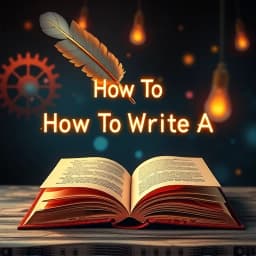
How to Write a Reasoning
Find this useful? Bookmark ( CTRL/CMD + D ) for quick access!
Try an example:
Academic Essay Structuring
Debate Argument Development
Creative Writing Prompts
Business Proposal Justification
Legal Reasoning Frameworks
Personal Statement Guidance
Explore Similar Tools
Recent Generations
the amount paid directly to you. Yes it is possible in future cases to request direct payment to the provider, Rephrase and give me polished email.
we have processed the claim as per the attachments in the claim submission we have processedthe invoice for Saul Holding. We dont have invoice for the Salofalk.
this additional information is very important. this adiitional information was requested by our clinical team. Without clinical review claim not be paid so please share the below additional information
How To Write A Reasoning
How To Write A Reasoning is a powerful AI-powered writing assistant that helps users craft clear and compelling reasoning for their arguments. This innovative solution combines advanced natural language processing with intuitive guidance to deliver well-structured and persuasive content.
Key Capabilities
- Structured Argument Development with step-by-step prompts to help users build logical and coherent arguments.
- Real-time Feedback enabling instant revisions and suggestions to enhance clarity and effectiveness.
- Diverse Writing Styles for tailoring reasoning to specific audiences, whether academic, professional, or casual.
- Plagiarism Detection to ensure originality and integrity in all written content.
Who It's For
Designed for students, professionals, and anyone looking to improve their writing skills, How To Write A Reasoning excels in academic writing, business proposals, and persuasive essays. Whether you're drafting a thesis or preparing a presentation, this tool streamlines your workflow and enhances productivity.
Why Choose How To Write A Reasoning
What sets How To Write A Reasoning apart is its user-friendly interface and personalized writing assistance, making it the ideal solution for anyone seeking to articulate their thoughts clearly and convincingly.
Ready to transform your writing process? Start using How To Write A Reasoning today and experience the difference in your reasoning skills!
Enhance Your Work with How to Write a Reasoning
Leverage the power of AI to streamline your tasks with our How to Write a Reasoning tool.
Guided Writing Prompts
Receive tailored prompts that guide you through the reasoning process, helping you articulate your thoughts clearly.
Structured Frameworks
Utilize predefined frameworks for organizing your reasoning, ensuring logical flow and coherence in your writing.
Idea Generation
Leverage AI to brainstorm and generate innovative ideas, enhancing the depth and creativity of your reasoning.
How How to Write a Reasoning Works
Discover the simple process of using How to Write a Reasoning to improve your workflow:
Define Your Topic
Start by clearly defining the topic or question you want to reason about.
Gather Supporting Evidence
Collect relevant facts, data, and examples that support your reasoning.
Construct Your Argument
Organize your evidence into a coherent argument that logically supports your conclusion.
Review and Revise
Review your reasoning for clarity and coherence, making necessary revisions.
Use Cases of
How to Write a Reasoning
Explore the various applications of How to Write a Reasoning in different scenarios:
Academic Writing Assistance
Help students and researchers articulate their arguments and reasoning in essays and research papers, enhancing clarity and coherence.
Business Proposal Development
Guide professionals in crafting persuasive business proposals by structuring their reasoning and supporting arguments effectively.
Legal Argumentation
Assist legal professionals in formulating logical arguments and reasoning for cases, ensuring that their positions are well-supported and compelling.
Debate Preparation
Aid debaters in organizing their thoughts and constructing logical reasoning to strengthen their positions and counterarguments during debates.
Who Benefits from How to Write a Reasoning?
AI-Powered Efficiency
From individuals to large organizations, see who can leverage How to Write a Reasoning for improved productivity:
Students
Enhance critical thinking and writing skills for academic success.
Content Creators
Craft compelling narratives and arguments to engage audiences effectively.
Educators
Develop structured lesson plans and assessments that foster reasoning skills.
Researchers
Formulate clear hypotheses and articulate findings in a persuasive manner.
Frequently Asked Questions
What is 'How To Write A Reasoning' AI tool used for?
The 'How To Write A Reasoning' AI tool is designed to assist users in crafting logical and coherent arguments. It helps in structuring thoughts, providing evidence, and enhancing the overall clarity of reasoning in written content.
Is the tool suitable for academic writing?
Yes, the tool is particularly useful for academic writing as it guides users in developing structured arguments, supporting claims with evidence, and adhering to academic standards of reasoning.
Can I use this tool for creative writing?
While the primary focus of the tool is on logical reasoning, it can also be beneficial for creative writing by helping authors articulate their ideas clearly and develop compelling narratives through structured reasoning.
Does the tool provide examples of reasoning?
Yes, the tool includes a variety of examples and templates that illustrate effective reasoning techniques. Users can refer to these examples to enhance their understanding and application of reasoning in their writing.
Is there a limit to the length of text I can input?
The tool can handle a wide range of text lengths, but there may be practical limits based on performance. For optimal results, we recommend keeping inputs concise and focused on specific arguments or points.
































